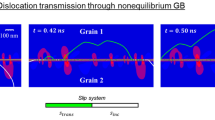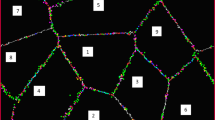Abstract
Large-scale molecular dynamics simulations are used to study strain and stress localization in atomistic polycrystalline FCC digital samples in a thin-film configuration, deformed in tension. Special focus is placed on the effects of additional grain boundary disorder on the dislocation–grain boundary interaction. The development of the localized stress and strain regions is studied as dislocations are emitted from and arrive at grain boundaries. Digital samples with two different degrees of disorder in the grain boundaries but otherwise identical microstructures are compared in order to understand the effects of additional defects on the stress concentration that develops at the grain boundaries. Localization phenomena are found to depend on the details of the grain boundary defect structure and relaxation state. The results clearly show that the samples with more disordered grain boundaries are more prone to strain and stress localization, with a higher fraction of atoms experiencing extreme deformation. The simulation results are validated by comparison with the predictions of continuum theories and experimental measurements of localized stress performed in austenitic stainless steel.













Similar content being viewed by others
References
X.M. Bai, L.J. Vernon, R.G. Hoagland, A.F. Voter, M. Nastasi, and B.P. Uberuaga: Phys. Rev. B, 2012, vol. 85, art. no. 214103.
W. S. Yu and S. P. Shen, International Journal of Plasticity, 2016, 85, 93-109.
B. L. Adams, B. S. El-Dasher, R. Merrill, J. Basinger and D. S. Li, Solid Mech Appl, 2004, 114, 315-323.
M. Kiritani, N. Yoshida, H. Takata and Y. Maehara, J Phys Soc Jpn, 1975, 38, 1677-1686.
R. S. Averback, J Nucl Mater, 1994, 216, 49-62.
J. S. Robach, I. M. Robertson, B. D. Wirth and A. Arsenlis, Philos. Mag., 2003, 83, 955-967.
Y. Matsukawa, Y. N. Osetsky, R. E. Stoller and S. J. Zinkle, Philos. Mag., 2008, 88, 581-597.
Z. Jiao and G. S. Was, J Nucl Mater, 2008, 382, 203-209.
K. Farrell, T. S. Byun and N. Hashimoto, J Nucl Mater, 2004, 335, 471-486.
Z. Jiao and G. S. Was, J Nucl Mater, 2011, 408, 246-256.
R. P. Tucker, M. S. Wechsler and S. M. Ohr, J Appl Phys, 1969, 40, 400–408.
M. D. McMurtrey, B. Cui, I. Robertson, D. Farkas and G. S. Was, Current Opinion in Solid State & Materials Science, 2015, 19, 305-314.
M. N. Gussev, K. G. Field and J. T. Busby, J Nucl Mater, 2015, 460, 139-152.
T. S. Byun and N. Hashimoto, Am Soc Test Mater, 2008, 1492, 121-133.
D. C. Johnson, B. Kuhr, D. Farkas and G. S. Was, Scripta Materialia, 2016, 116, 87-90.
A. N. Stroh, Proc R Soc Lon Ser-A, 1954, 223, 404-414.
J. D. Eshelby, F. C. Frank and F. R. N. Nabarro, Philos. Mag., 1951, 42, 351-364.
J. F. Nye, Acta Metall Mater, 1953, 1, 153-162.
M. Calcagnotto, D. Ponge, E. Demir and D. Raabe, Mater. Sci. Eng. A, 2010, 527, 2738-2746.
M. Kamaya, Mater Charact, 2012, 66, 56-67.
Y. Guo, T. B. Britton and A. J. Wilkinson, Acta Mater, 2014, 76, 1-12.
T. B. Britton and A. J. Wilkinson, Acta Mater, 2012, 60, 5773-5782.
Y. Guo, D. M. Collins, E. Tarleton, F. Hofmann, J. Tischler, W. Liu, R. Xu, A. J. Wilkinson and T. B. Britton, Acta Mater, 2015, 96, 229-236.
E. B. Webb, J. A. Zimmerman and S. C. Seel, Math Mech Solids, 2008, 13, 221-266.
A. C. Eringen, Int J Eng Sci, 1977, 15, 177-183.
Z. L. Pan and T. J. Rupert, Acta Mater, 2015, 89, 205-214.
N. J. Burbery, R. Das and W. G. Ferguson, Comput. Mater. Sci., 2015, 101, 16-28.
N. J. Burbery, R. Das and W. G. Ferguson, Acta Mater, 2016, 108, 355-366.
D. Foley and G.J. Tucker: Model. Simul. Mater. Sci., 2016, vol. 24, art. no. 075011.
G. J. Tucker and D. L. McDowell, International Journal of Plasticity, 2011, 27, 841-857.
J. V. Sharp, Philos. Mag., 1967, 16, 77–96.
A. Patra and D. L. McDowell, Acta Mater, 2016, 110, 364-376.
M. D. McMurtrey, G. S. Was, L. Patrick and D. Farkas, Mater. Sci. Eng. A, 2011, 528, 3730-3740.
D. Farkas, Curr. Opin. Solid State Mater., 2013, 17, 284-297.
S. Plimpton, J Comput Phys, 1995, 117, 1-19.
G. Bussi, T. Zykova-Timan, and M. Parrinello, J. Chem. Phys., 2009, vol. 130, art. no. 074101.
M. S. Daw and M. I. Baskes, Phys. Rev. B, 1984, 29, 6443-6453.
A.F. Voter and S.P. Chen, MRS Symp. Proc., 1987, vol. 82, pp. 175–180.
C. L. Kelchner, S. J. Plimpton and J. C. Hamilton, Phys. Rev. B, 1998, 58, 11085-11088.
A. Stukowski: Modell. Simul. Mater. Sci. Eng., 2010, vol. 18, art. no. 085001.
F. Shimizu, S. Ogata and J. Li, Mater Trans, 2007, 48, 2923-2927.
A. J. Wilkinson, G. Meaden and D. J. Dingley, Mater Sci Tech-Lond, 2006, 22, 1271-1278.
H. Van Swygenhoven, M. Spaczer, A. Caro and D. Farkas, Phys. Rev. B, 1999, 60, 22-25.
X. Y. Sun, C. Fressengeas, V. Taupin, P. Cordier and N. Combe, International Journal of Plasticity, 2018, 104, 134-146.
D. L. Olmsted, S. M. Foiles and E. A. Holm, Acta Mater, 2009, 57, 3694-3703.
J. Weertman, Dislocation based fracture mechanics, World Scientific, Singapore; River Edge, N.J., 1996.
M. D. McMurtrey, G. S. Was, B. Cui, I. Robertson, L. Smith and D. Farkas, International Journal of Plasticity, 2014, 56, 219-231.
D. C. Johnson, B. Kuhr, D. Farkas and G. S. Was, Acta Materialia, 2019, 170, 166- 175.
W. A. T. Clark, R. H. Wagoner, Z. Y. Shen, T. C. Lee, I. M. Robertson and H. K. Birnbaum, Scripta Metallurgica Et Materialia, 1992, 26, 203-206.
A. Hasnaoui, P. M. Derlet and H. Van Swygenhoven, Acta Mater, 2004, 52, 2251-2258.
M. P. Dewald and W. A. Curtin, Philos. Mag., 2007, 87, 4615-4641.
J. Kacher, B. P. Eftink, B. Cui and I. M. Robertson, Curr. Opin. Solid State Mater., 2014, 18, 227-243.
Z. L. Pan and T. J. Rupert, Comput. Mater. Sci., 2014, 93, 206-209.
S. Chandra, M. K. Samal, V. M. Chavan and R. J. Patel, Mater. Sci. Eng. A, 2015, 646, 25-32.
W. S. Yu, Z. Q. Wang and S. P. Shen, Comput. Mater. Sci., 2017, 137, 162-170.
K. Kinoshita, T. Shimokawa and T. Kinari, Mater Trans, 2012, 53, 147-155.
T. Shimokawa, T. Hiramoto, T. Kinari and S. Shintaku, Mater Trans, 2009, 50, 2-10.
P. R. M. van Beers, V. G. Kouznetsova and M. G. D. Geers, Mech Mater, 2015, 90, 69-82.
Acknowledgments
This work was supported by the U.S. Department of Energy, Office of Science, Basic Energy Sciences, under grant DE-FG02-08ER46525. The authors would like to acknowledge Advanced Research Computing at Virginia Tech for providing computational resources and technical support that have contributed to the results reported within this paper (www.arc.vt.edu). The simulations in this paper were run using the LAMMPS software package (lammps.sandia.gov). Figures were generated using OVITO (www.ovito.org).
Author information
Authors and Affiliations
Corresponding author
Additional information
Publisher's Note
Springer Nature remains neutral with regard to jurisdictional claims in published maps and institutional affiliations.
Manuscript submitted June 12, 2019.
Rights and permissions
About this article
Cite this article
Kuhr, B., Farkas, D., Robertson, I.M. et al. Stress Localization Resulting from Grain Boundary Dislocation Interactions in Relaxed and Defective Grain Boundaries. Metall Mater Trans A 51, 667–683 (2020). https://doi.org/10.1007/s11661-019-05534-0
Received:
Published:
Issue Date:
DOI: https://doi.org/10.1007/s11661-019-05534-0




